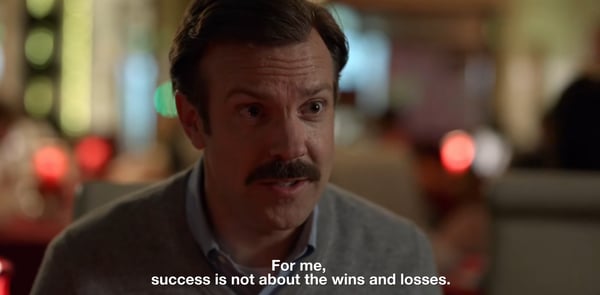Ted Lasso's infectious optimism and leadership style have captured the hearts of audiences worldwide, offering a refreshing perspective amidst the trials of everyday life.
If you aren’t familiar with this award-winning show on Apple TV+, here is a quick synopsis:
Ted Lasso (played by Jason Sudeikis) is an American football coach who moves to London to coach AFC Richmond, a fictional UK Premier League English football (soccer) club. The comedy follows Ted, his assistant coaches, and players as they navigate their season and the accompanying challenges and triumphs.
Five Nonprofit Leadership Lessons Inspired by Ted Lasso
1. Believe.
In season one, Ted slaps a makeshift “Believe” sign in the team’s locker room above his office door. Initially perceived as a cheesy gesture, with Ted’s team development efforts, this sign becomes an important symbol of hope.
 Within philanthropy and mission-driven work, it’s imperative to believe in your team and your mission. If you have moments of disbelief, return to your core values, and ruminate on your “why.” This will provide you with a sense of direction when your work may seem aimless.
Within philanthropy and mission-driven work, it’s imperative to believe in your team and your mission. If you have moments of disbelief, return to your core values, and ruminate on your “why.” This will provide you with a sense of direction when your work may seem aimless.
2. Admit when you need help.
Ted surrounds himself with his coaching staff (nicknamed the ‘Diamond Dogs’) that aid him in his decision-making. To scale your organization’s critical work, you must delegate to your leadership team and board. When you are in a pinch or need assistance, call upon your ‘trusted advisors’ for feedback. With a team of experts contributing to problem-solving, you will more quickly and easily determine a solution.
3. Foster individual growth of your team.
Ted takes the time to get to know his team and uncover each player’s unique motivations and challenges. In season one, he gives each player an inspirational book to inspire him to reach his full potential.
Professional development is personal development. As a nonprofit leader, if you take the time to determine each team member’s passion as it relates to her or his role, you can foster that motivation. If your team feels “seen,” they will be more likely to work efficiently, effectively, and passionately for the betterment of the organization.
4. Celebrate the small wins.
In season one, Ted hosts a birthday party for one of his players despite their having lost a game earlier that day. He receives criticism that he is not focused on winning, but Ted states:

“For me, success is not about the wins and losses. It’s about helping these young fellas be the best versions of themselves on and off the field.”
Each small success is a reason to celebrate and recognize your team. For example, if your events team hosted their first hybrid event with meeting 25% of the fundraising goal, recognize their efforts, and encourage them to utilize the experience as a learning opportunity.
5. Make difficult decisions for the betterment of the organization.
As coach, Ted has to make difficult, unpopular decisions for the long-term development of the team. One of these decisions includes benching one of his top players during the midst of a tough game.
Nonprofit leaders must be willing to take risks despite criticism or fear. Your team will respect your ability to act, and they will appreciate the clarity your tough decisions will provide.
The work of a nonprofit leader can be grueling but also incredibly rewarding. Keep these five lessons in mind whenever you need reassurance and remember:
“I believe in hope. I believe in Believe."
Eager for more on effective nonprofit leadership tips? Download our whitepaper: Six Ways to be an Effective Nonprofit Leader







